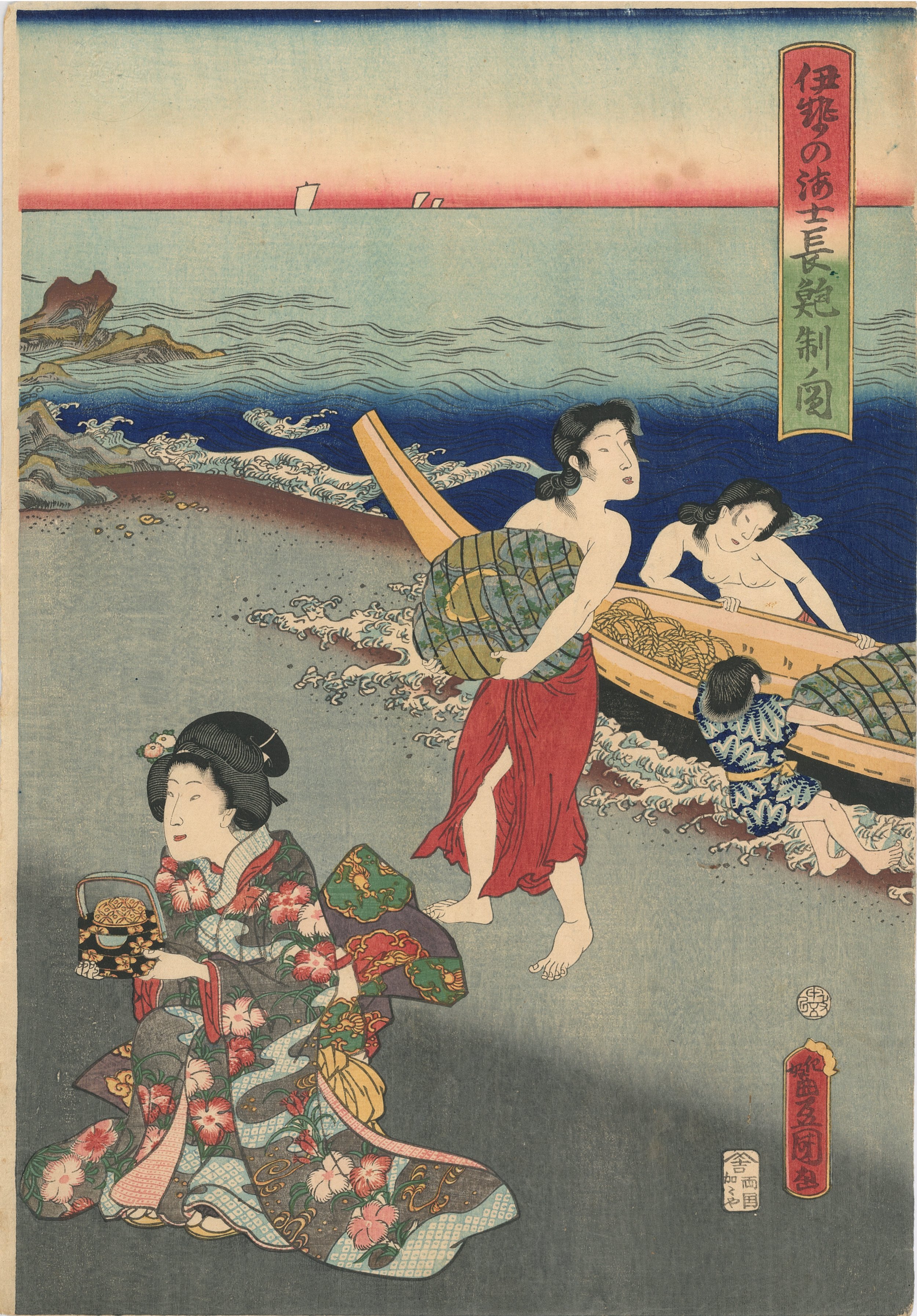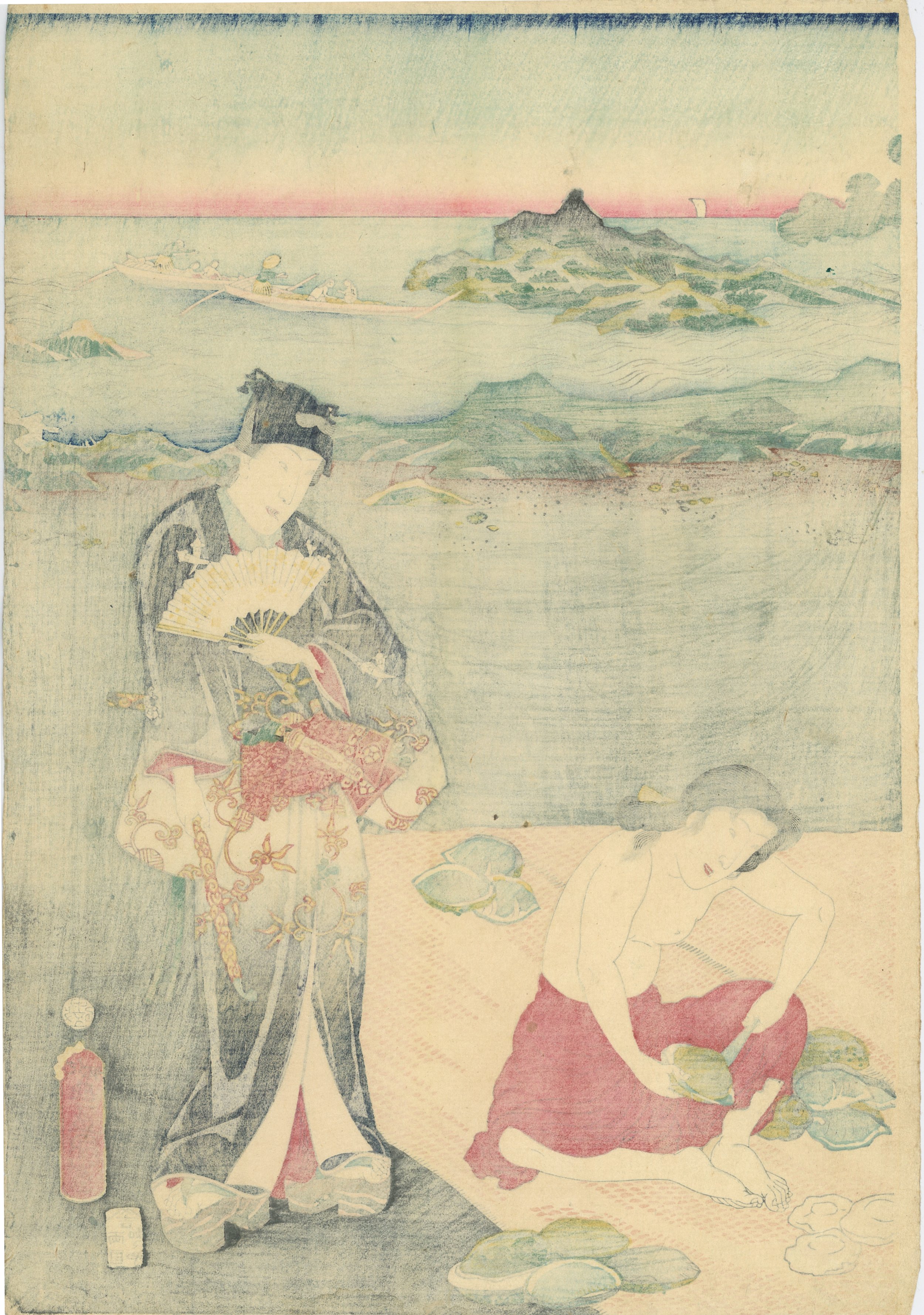Toyokuni III | Female abalone hunters of Ise Province making peeled abalones
三代目歌川豐国 Utagawa Toyokuni III (1786–1865)
伊勢の海士長鮑制図
Female abalone hunters of Ise Province making peeled abalones
1860
木版画 | 三联续绘-纵绘大判 | 36.9cm x 25.6cm x 3
Woodblock-print | Triptych Oban tate-e triptych | 36.9cm x 25.6cm x 3
非常早期版本及版次,带清晰的木纹;颜色鲜艳;整体品相非常好;右联有轻微黄斑
Early edition and impression, with beautiful woodgrain; great color; some slight stains on the right sheet, otherwise excellent condition.
$4,500
The Ama were female divers who descended to remarkable depths for extended periods of time, holding their breaths all along, cutting large clam-like abalones from the rocky seabed off the coast of Ise, about a week’s walk from Kyoto. They hunted for pearls in the abalones, but even if one wasn’t found, the catch was still a delicacy. It would be cut into strips, hammered into tenderness and then cooked slowly, or lightly, often in soy sauce.
These graceful and strong women divers have intrigued writers, poets and artists for more than 2,000 years – and still do today (although their ranks are fast diminishing). Of course, as far as Ukiyoe is concerned, one reason was their attire – until the 1950s, they wore nothing but loincloths. (Today they wear wetsuits.) Naturally, their strenuous physical activity during diving season meant they were also in great shape.
In this wonderful triptych from Toyokuni III (Kunisada) we see the divers and all steps of the abalone preparing process – from bringing them from the sea, to knifing them out of their shells, to cutting them into strips. Interestingly, even though they are no longer diving, the women remain topless – surely, a fanciful device of the artist to satisfy the male gaze. Two wooden boats bob in the current in the distance, with women either preparing to dive, or having just returned to the surface.
In another fanciful touch, Prince Genji has magically appeared roughly 700 years after he lived to watch the swimmers go about their work. (This is one of many Kunisada/Toyokuni III works that bring the dashing and amorous Genji into then-modern times.) His kimono is a beautiful and rich purple, demonstrating the fine condition of this triptych, as purple tends to be the first color to fade over time.
Interested in purchasing?
Please contact us.
三代目歌川豐国 Utagawa Toyokuni III (1786–1865)
伊勢の海士長鮑制図
Female abalone hunters of Ise Province making peeled abalones
1860
木版画 | 三联续绘-纵绘大判 | 36.9cm x 25.6cm x 3
Woodblock-print | Triptych Oban tate-e triptych | 36.9cm x 25.6cm x 3
非常早期版本及版次,带清晰的木纹;颜色鲜艳;整体品相非常好;右联有轻微黄斑
Early edition and impression, with beautiful woodgrain; great color; some slight stains on the right sheet, otherwise excellent condition.
$4,500
The Ama were female divers who descended to remarkable depths for extended periods of time, holding their breaths all along, cutting large clam-like abalones from the rocky seabed off the coast of Ise, about a week’s walk from Kyoto. They hunted for pearls in the abalones, but even if one wasn’t found, the catch was still a delicacy. It would be cut into strips, hammered into tenderness and then cooked slowly, or lightly, often in soy sauce.
These graceful and strong women divers have intrigued writers, poets and artists for more than 2,000 years – and still do today (although their ranks are fast diminishing). Of course, as far as Ukiyoe is concerned, one reason was their attire – until the 1950s, they wore nothing but loincloths. (Today they wear wetsuits.) Naturally, their strenuous physical activity during diving season meant they were also in great shape.
In this wonderful triptych from Toyokuni III (Kunisada) we see the divers and all steps of the abalone preparing process – from bringing them from the sea, to knifing them out of their shells, to cutting them into strips. Interestingly, even though they are no longer diving, the women remain topless – surely, a fanciful device of the artist to satisfy the male gaze. Two wooden boats bob in the current in the distance, with women either preparing to dive, or having just returned to the surface.
In another fanciful touch, Prince Genji has magically appeared roughly 700 years after he lived to watch the swimmers go about their work. (This is one of many Kunisada/Toyokuni III works that bring the dashing and amorous Genji into then-modern times.) His kimono is a beautiful and rich purple, demonstrating the fine condition of this triptych, as purple tends to be the first color to fade over time.
Interested in purchasing?
Please contact us.
三代目歌川豐国 Utagawa Toyokuni III (1786–1865)
伊勢の海士長鮑制図
Female abalone hunters of Ise Province making peeled abalones
1860
木版画 | 三联续绘-纵绘大判 | 36.9cm x 25.6cm x 3
Woodblock-print | Triptych Oban tate-e triptych | 36.9cm x 25.6cm x 3
非常早期版本及版次,带清晰的木纹;颜色鲜艳;整体品相非常好;右联有轻微黄斑
Early edition and impression, with beautiful woodgrain; great color; some slight stains on the right sheet, otherwise excellent condition.
$4,500
The Ama were female divers who descended to remarkable depths for extended periods of time, holding their breaths all along, cutting large clam-like abalones from the rocky seabed off the coast of Ise, about a week’s walk from Kyoto. They hunted for pearls in the abalones, but even if one wasn’t found, the catch was still a delicacy. It would be cut into strips, hammered into tenderness and then cooked slowly, or lightly, often in soy sauce.
These graceful and strong women divers have intrigued writers, poets and artists for more than 2,000 years – and still do today (although their ranks are fast diminishing). Of course, as far as Ukiyoe is concerned, one reason was their attire – until the 1950s, they wore nothing but loincloths. (Today they wear wetsuits.) Naturally, their strenuous physical activity during diving season meant they were also in great shape.
In this wonderful triptych from Toyokuni III (Kunisada) we see the divers and all steps of the abalone preparing process – from bringing them from the sea, to knifing them out of their shells, to cutting them into strips. Interestingly, even though they are no longer diving, the women remain topless – surely, a fanciful device of the artist to satisfy the male gaze. Two wooden boats bob in the current in the distance, with women either preparing to dive, or having just returned to the surface.
In another fanciful touch, Prince Genji has magically appeared roughly 700 years after he lived to watch the swimmers go about their work. (This is one of many Kunisada/Toyokuni III works that bring the dashing and amorous Genji into then-modern times.) His kimono is a beautiful and rich purple, demonstrating the fine condition of this triptych, as purple tends to be the first color to fade over time.
Interested in purchasing?
Please contact us.
Utagawa Toyokuni III (1786–1865)
In the pantheon of Japanese woodblock prints, some names loom large and legendary – Hokusai, Hiroshige, Utamaro, to name a few. Each in his own way revolutionized his genre. But for sheer productivity and quality and longevity, no one rivals the great Utagawa Kunisada. He was without a doubt the most prolific Ukiyo-e artist of the Edo period, and the quality of his work was remarkably high throughout his lifetime.
His life caught the tail end of the early golden age of Ukiyo-e and ended during the final, halcyon days of Japanese woodblock printmaking. His legacy lived on with many famous pupils. In between, he produced countless designs of bijin (beautiful women), warriors, legends, Surimono, more bijin, the Tale of Genji, actors, landscapes, Shunga, fan prints and even more bijin. He led the Utagawa School, home to Hiroshige among others, for nearly 40 years.
His work embraced a subtle elegance and simplicity, a timelessness, when other woodblock artists often favored busy energy. Except when it didn’t. (Read on.)
He was born in 1796 and always had a steady income from his family’s ferry business – making him unusual in the world of Ukiyo-e, where so many struggled to make ends meet. He became a student of Toyokuni when he was 15. The master gave him the name Kunisada, using the tradition of a teacher starting a student’s name with the end of his own.
After getting his start doing book designs, Kunisada saw his first major successes in the 1820s. His initial specialties were bijin and warriors, as well as erotic books. He often put his subjects in well-drawn landscapes but rarely produced pure landscapes themselves.
One example of this occurred in the early 1830s when, reacting to the runaway success of Hiroshige’s Great Tokaido series, he began his own series that copied Hiroshige’s designs but placed a beautiful woman in the foreground. While Hiroshige’s prints were oban yoko-e (horizontal oban prints), Kunisada’s “copies” were smaller chuban-size prints, meaning two could be cut from a single oban-sized sheet. These little prints were phenomenally successful – as successful at least as Hiroshige’s – and eventually Kunisada was publishing his little Tokaido prints ahead of Hiroshige’s, and thus designing his own background landscapes.
Kunisada would later produce the “two-brush” Tokaido series with Hiroshige in the 1850s, in which he drew figures in the foreground while Hiroshige supplied beautiful little landscapes behind them. This was one of several notable woodblock print collaborations during his lifetime.
By then, Kunisada had taken the name Toyokuni III, to honor his master. (Toyokuni II had already been taken by Toyoshige, though Kunisada didn’t acknowledge the legitimacy. But that’s another story for another day.)
He kept going and going. In fact, in his long life, 1852 was his most productive year. His design skills were later matched by new technologies in woodblock prints, and some of his final series feature spectacular and intricate production, such as “Lasting Impressions of a Later Genji Collection” in 1859-61 and “A Contest of Magic Scenes by Toyokuni” in 1861-4. Okay – this series was not subtle: It featured over-the-top designs of Kabuki actors with fabled and ghostly beasts. Double-printing, mica, burnishing, raised printing, heavy paper, complex bokashi – no expense was spared for these deluxe editions.
Kunisada was generous with his students, many of whom went on to great success, including Kunichika, Kunisada II, Sadahide, and Kunihisa II. This last pupil, who among other projects designed the in-set landscapes in Kunisada’s wonderful “100 Famous Sights in Edo Matched with Beautiful Women” in 1857-1858, was a rarity among Ukiyo-e artists – a woman.
Kunisada died in 1865, just three years before the end of the Tokugawa epoch, leaving behind a body of work unmatched in his time.
Don’t believe me? Checkout The Kunisada Project. It’s all there. Just make sure you have some time.
Citation: Research for this brief biography included “Japanese Woodblock Prints” by Andreas Marks (Tuttle; 2010), among other sources.








